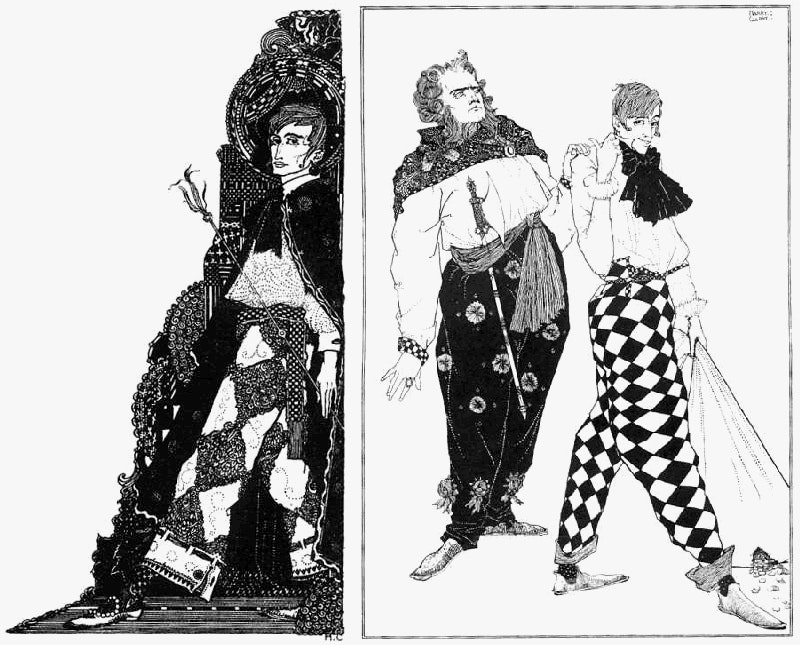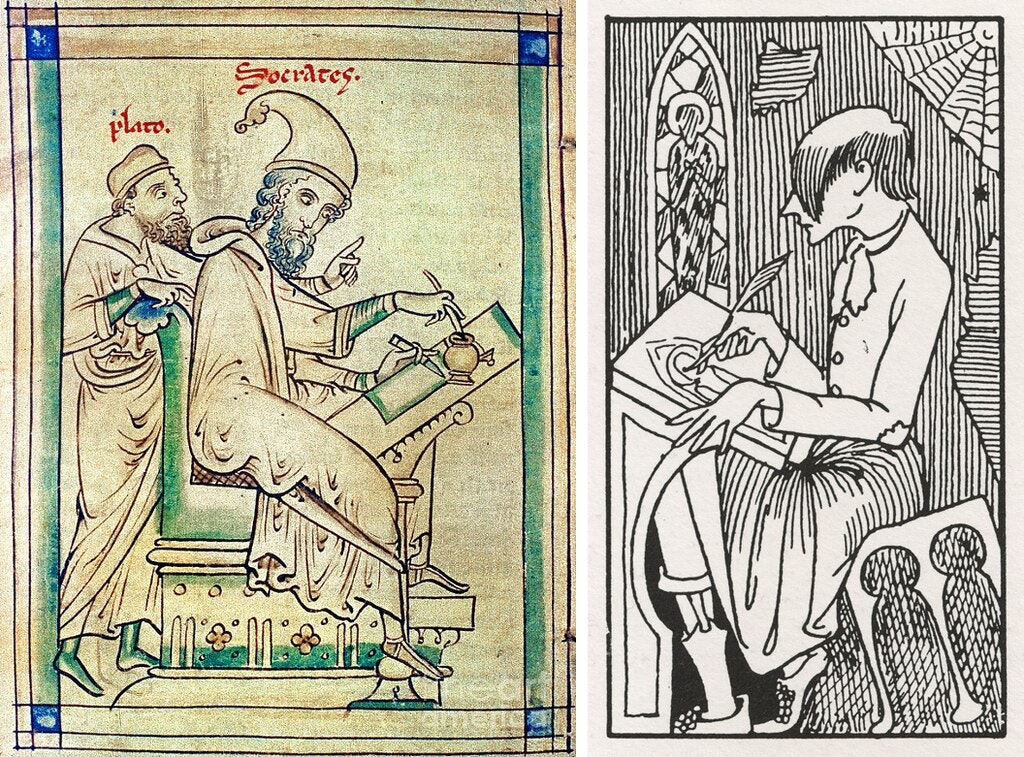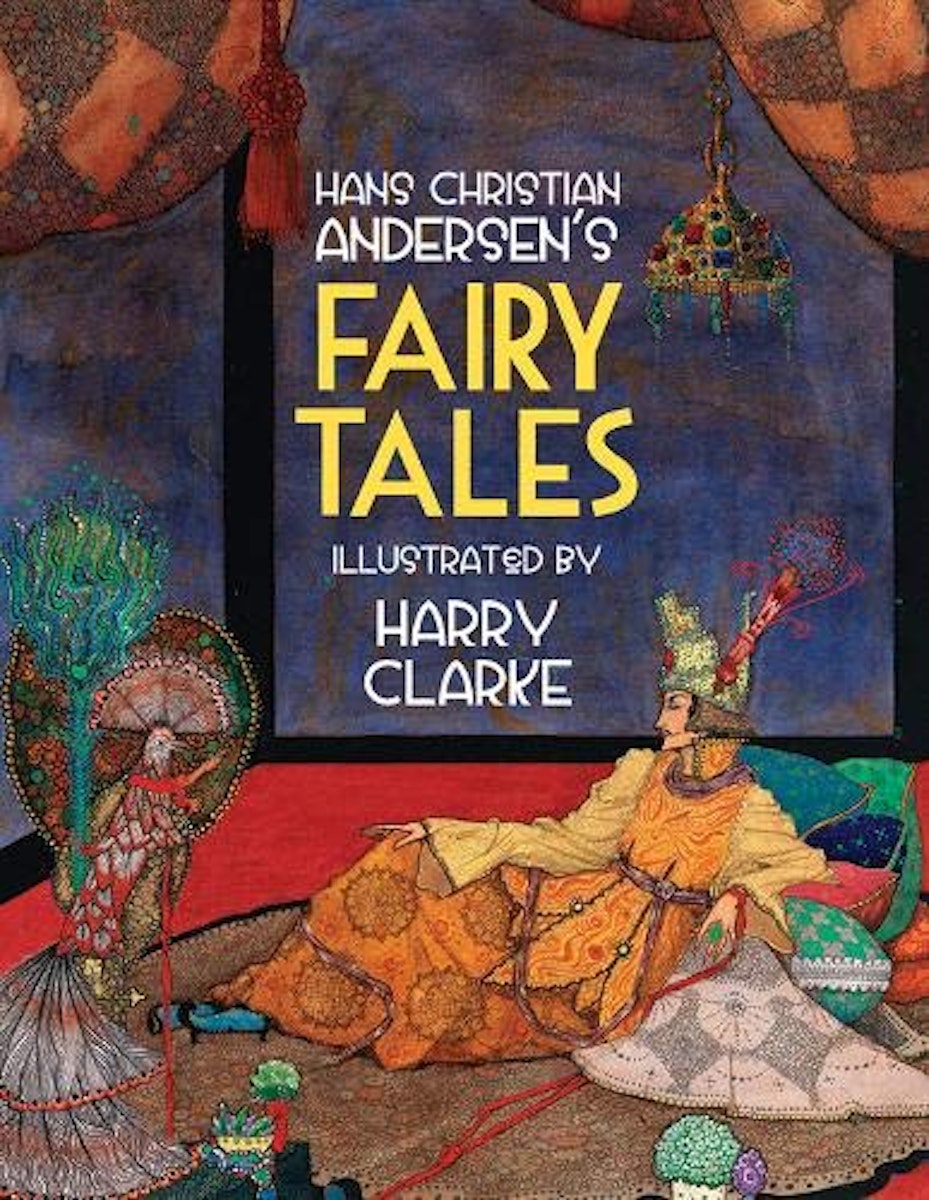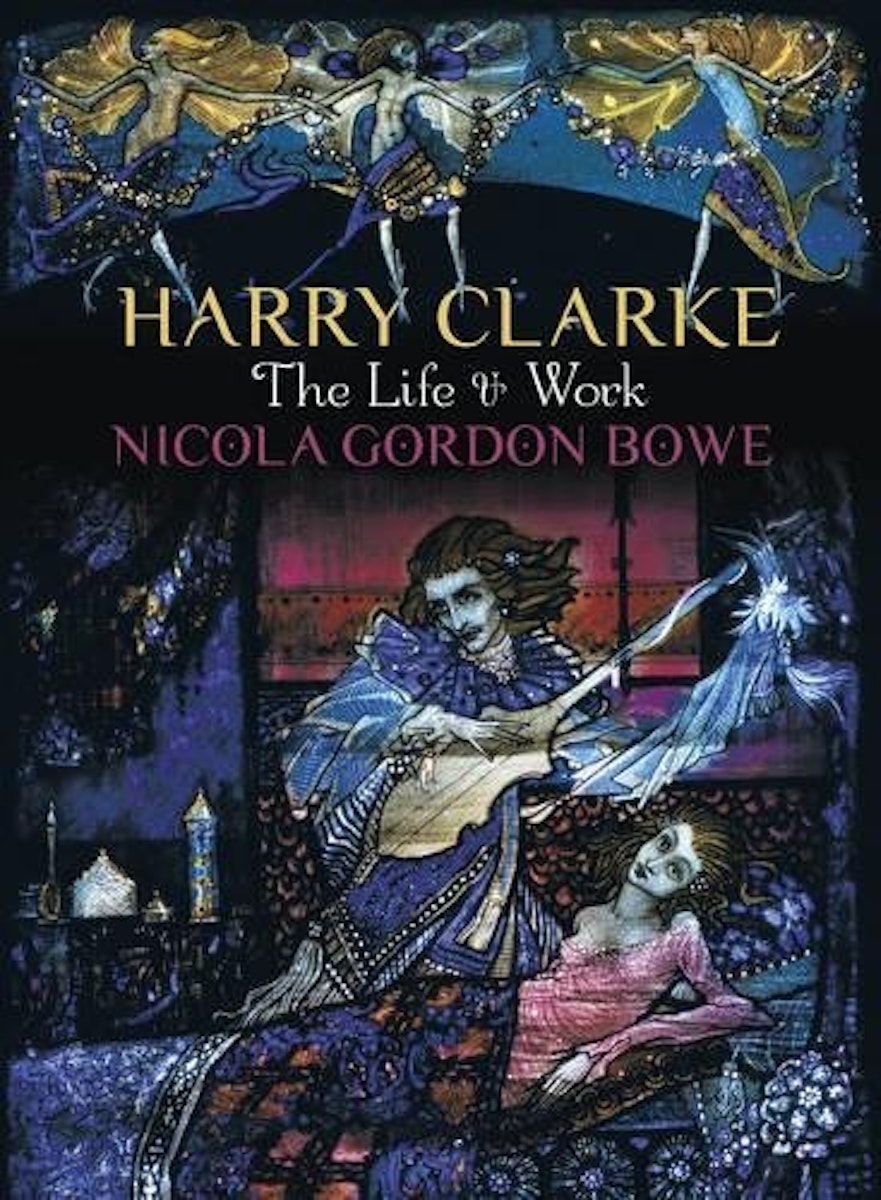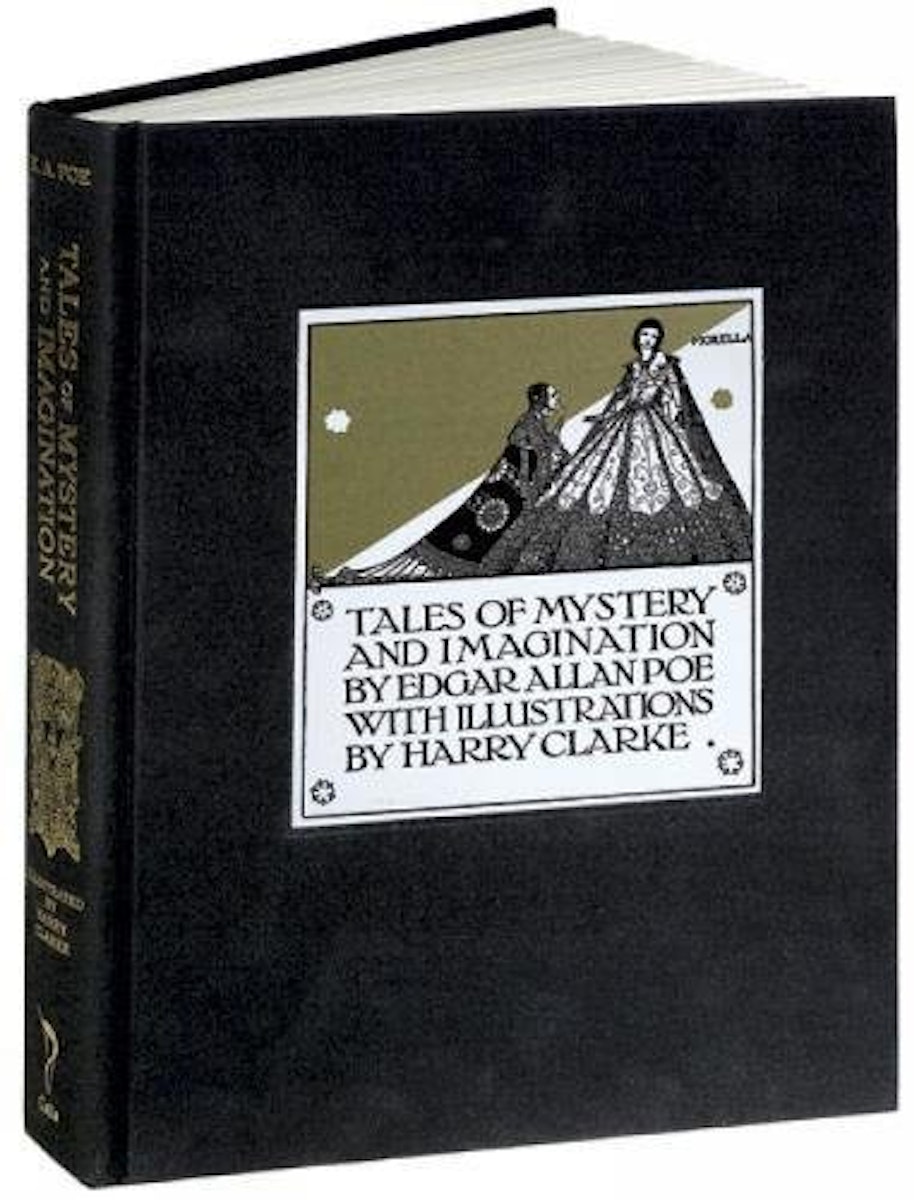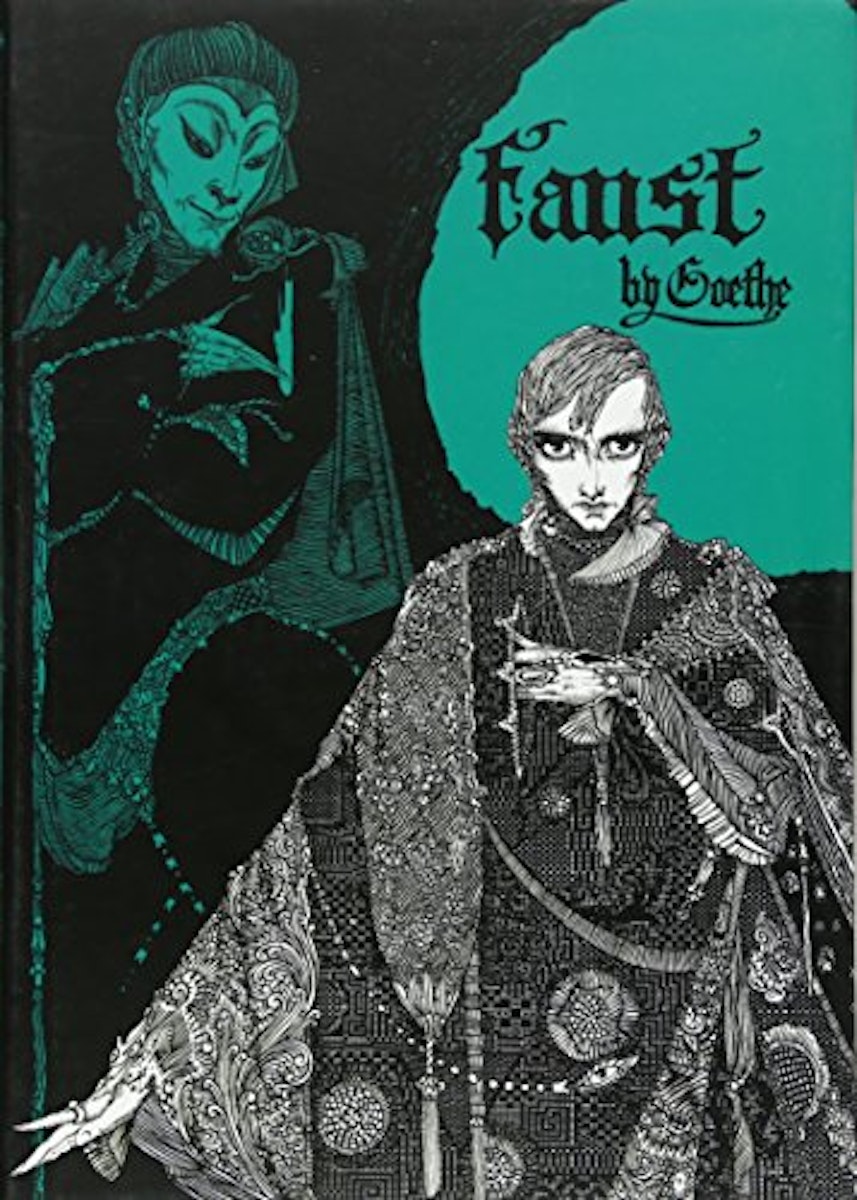
Harry Clarke’s Looking Glass
With their intricate line and often ghoulish tone, the works of Irish artist Harry Clarke are amongst the most striking in the history of illustration and stained glass design. Kelly Sullivan explores how, unknown to many at the time, Clarke took to including his own face in many of his pictures.
October 12, 2016
 Scroll through the whole page to download all images before printing.
Scroll through the whole page to download all images before printing.Detail from one of Clarke’s illustrations for Faust by Goethe (1925), his own likeness used for the face of Faust — Source.
The Irish stained glass artist and illustrator Harry Clarke was prolific, producing, in his short life, over a hundred stained glass windows. But beyond Ireland, it was his illustrations that brought him international renown, particularly in the United States where printers flooded the market with pirated editions of the six illustrated books he produced between 1915 and 1931. His illustrated edition of Edgar Allan Poe’s Tales of Mystery and Imagination, published by George G. Harrap, London, in 1919 and reissued in 1923, was his most popular work, a macabre exploration of the human psyche. The cover to the second updated edition of 1923 shows a bearded figure pulling aside a stage curtain as if to welcome readers into the disturbing world of Poe’s — and Clarke’s — imagination. The stage itself appears empty but for a small door cut into the flat green wall in the background. Through the door, we see a miniature figure raising a mitre into the air. Clarke’s dust-jacket image is at once a symbolist invocation of horror, with its border of decaying carcasses, distorted figures, and larval growths, and also a deliberate reference to one of the most intriguing and enigmatic self-portraits in modern art history, Diego Velázquez’s Las Meninas (1656). Although Clarke does not portray himself on the cover of Poe, nor in the gruesome illustration for “The Case of M. Valdemar” which similarly alludes to Las Meninas, both images — with their significant perspectival gaze back to a small open door framing a silhouetted figure — signal Clarke’s abiding interest in hiding his own face in his works, and his recognition of the long history of self-representation in Western art.
In Las Meninas, Velázquez brings to center stage the newfound importance of the artist in the world of high society and culture. His painting, ostensibly a portrait of Infanta Margaret Theresa, playfully portrays the King and Queen — who would occupy the position of the viewer — in a mirror on the back wall. Yet key to the work is the tiny silhouette of the Queen’s chamberlain, a man reputed to be related to the artist, framed in a lighted doorway. This striking figure draws our attention to the artist himself, poised similarly at the left of the composition with his hand ready to put brush to canvas. Like the doubled royal portrait of both infant daughter and her parents, the painter doubles himself in this visual echo.
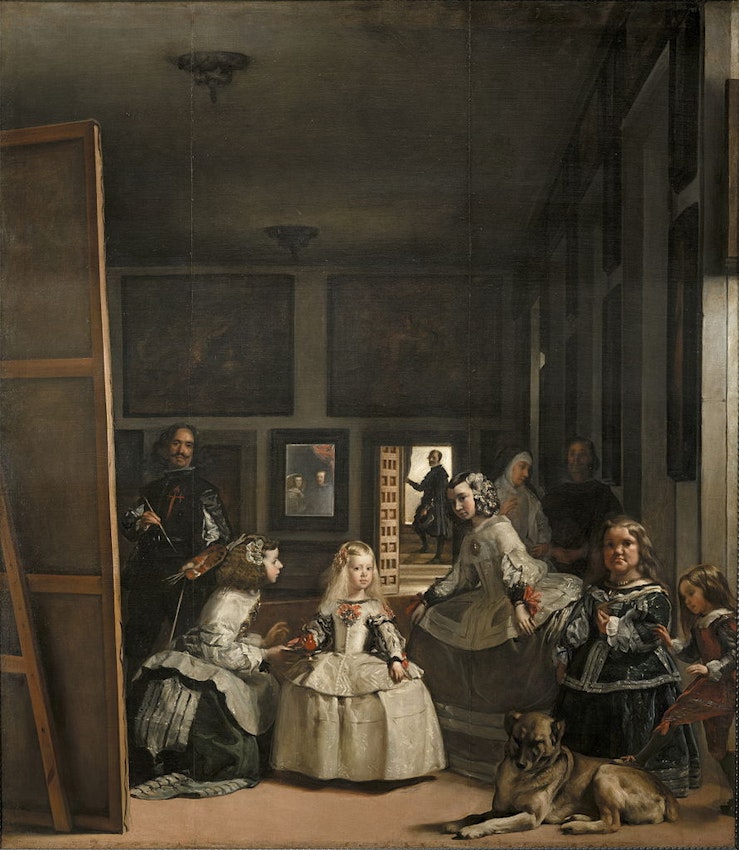 Scroll through the whole page to download all images before printing.
Scroll through the whole page to download all images before printing.Las Meninas (1656—7) by Diego Velázquez — Source.
Clarke’s cover image replicates the composition of Velázquez’s painting, but removes all the figures with the exception of the curtain-opening master of ceremonies — a figure in the position of the painter’s self-portrait — and the silhouette. Although Clarke’s bearded figure bears no resemblance to the artist himself, the structural allusion to Las Meninas serves as an invitation to recognize the many self-portraits Clarke did leave in stained glass, in illustrations, and in parodic caricatures sketched for friends. Through it, Clarke also signals his descent from a long line of artists drawn to the self-portrait, from medieval scribes who included their own figures in illuminated manuscripts, to Clarke’s drawing instructor at the Dublin Metropolitan School of Art, William Orpen, a well-known painter specialising in self-portraits, whose 1907 A Bloomsbury Family (an image Clarke likely saw in exhibition in Dublin) can be seen to also deliberately reference Las Meninas.
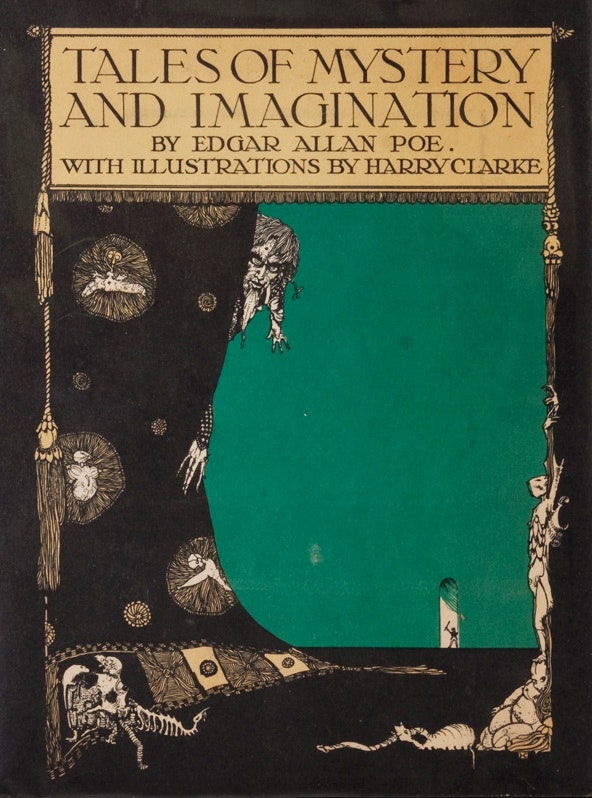 Scroll through the whole page to download all images before printing.
Scroll through the whole page to download all images before printing.Clarke’s cover for the 1923 US edition of Poe’s Tales of Mystery and Imagination — Source.
In his first completed book, the illustrated Fairy Tales of Hans Christian Andersen (1916), Clarke includes some of his most recognizable self-portraits. Before the stories even begin, we are faced with an image of Clarke, in the garb of a Harlequin figure, emerging as if stepping onto stage next to the “list of illustrations” — a playful reminder to recognize the artist behind the book.
In “Great Claus and Little Claus”, as the figure of Little Claus, the artist shows himself with his characteristic combed hair, again wearing the checkered pants of a Harlequin. Great Claus is reportedly his friend Vincent Wood. Clarke hides himself in the curtain framing the second drawing, distracting us from the more grotesque scene played out behind: Great Claus has just thrown a hatchet into the forehead of Little Claus’ grandmother (who happened to have been dead already).
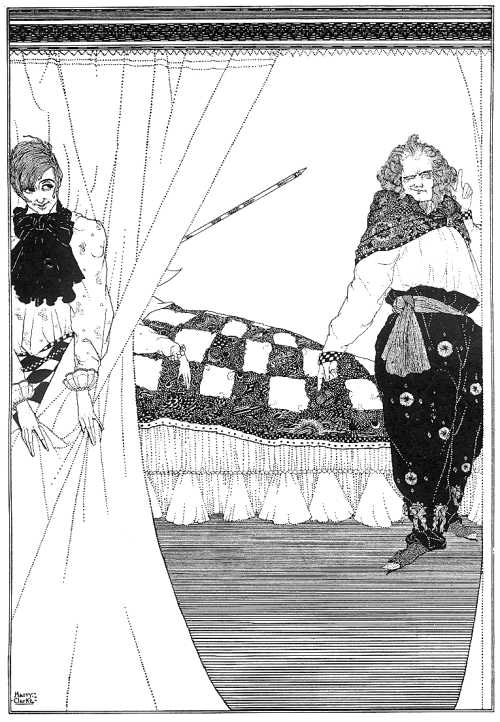 Scroll through the whole page to download all images before printing.
Scroll through the whole page to download all images before printing.The hatchet scene from “Great Claus and Little Claus”, Fairy Tales of Hans Christian Andersen (1916) — Source.
Already in this early self-portrait, Clarke associates himself with one of the comically gruesome elements of the work. As Little Claus, he outsmarts his neighbor, grows his fortune, and avoids an untimely death on several occasions — but he kills three men in the process. The color illustrations to this early work reproduced badly, but a robber holding aloft a medieval battle axe in his illustration for “The Snow Queen” seems to have Clarke’s features, and sports a grubby five o’clock shadow.
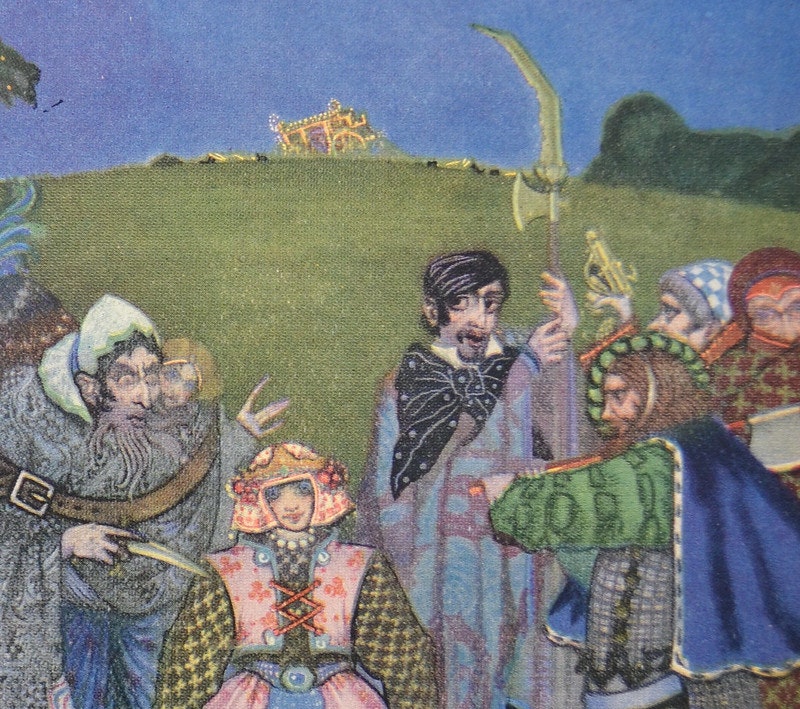 Scroll through the whole page to download all images before printing.
Scroll through the whole page to download all images before printing.Detail from an illustration for “The Snow Queen”, Fairy Tales of Hans Christian Andersen (1916) — Source.
Clarke presents himself as similarly bedraggled in the undated Self-Portrait as a Drunken Saint, a playful sketch in which he appears winged and haloed, with his iconic cigarette and unruly spike of hair at the back of his head. Yet for all its lightheartedness, this portrait hints at just how much pressure he must have felt to keep up with ecclesiastical stained glass commissions as well as book illustrations and orders for commercial clients. He worked seemingly endlessly, and suffered from poor health, a combination of which ultimately led to his early death in 1931, at only forty-one.
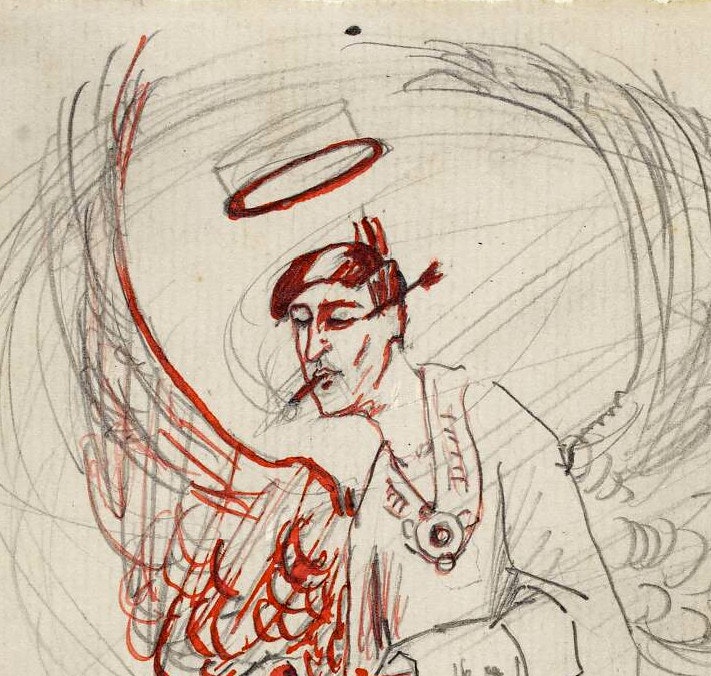 Scroll through the whole page to download all images before printing.
Scroll through the whole page to download all images before printing.Detail from Self-Portrait as a Drunken Saint — Source (not openly licensed).
In another undated caricature, this time as a monk working in a decaying medieval garret, Clarke shows himself designing a stained glass window, with another window hanging over his desk. Clarke’s caricature looks remarkably like the work of Matthew Paris, a thirteenth-century Benedictine monk known for his illuminated manuscripts, particularly his depiction of Plato watching Socrates write, the frontispiece to Prognostica Socratis basilei, a fortune-telling book held by the Bodleian Library, Oxford. Clarke would have been familiar with Paris’ work through his careful study of medieval art, and he likely knew Paris favored including self-portraits hidden in his illuminated manuscripts.
Some of Clarke’s most interesting drawings were made as gifts for friends, and so went unpublished (or, in some cases, were deemed too offensive by his publishers and pulled from books). In The Mad Mulrannies (an illustration to J. M. Synge’s Playboy of the Western World) given to Thomas Bodkin in 1917, Clarke includes a portrait of his friend Séan Keating whose easily distinguishable features adorn characters in many illustrations and at least one or two stained glass windows. The faces and figures of the Mulrannies seem to pile up endlessly, but Keating turns his head as if to address the figure next to him — a self-portrait of the artist, dressed in what might be the chasuble of a priest, and with his arms crossed in a symbolic manner.
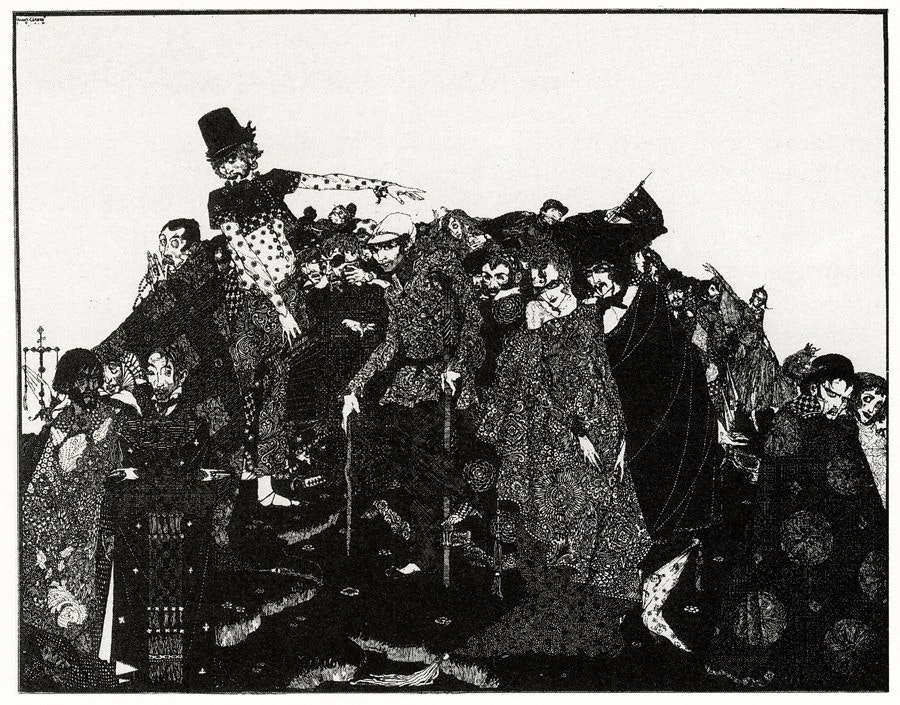 Scroll through the whole page to download all images before printing.
Scroll through the whole page to download all images before printing.Clarke’s The Mad Mulrannies, his own figure discernible to the bottom left — Source.
In one of Clarke’s most striking self-portraits, the 1914 Mephisto (produced a full decade before he would illustrate Goethe’s Faust), he depicts himself as Mephistopheles, a glass of absinthe held enticingly in his hand. This early portrait, with its bold use of a solid color wash in a fevered absinthe tint, draws a line of evolution through the similarly color-washed cover of Tales of Mystery and Imagination, to the vivid green of the end papers of his illustrated Faust by Goethe, published by Harrap in 1925.
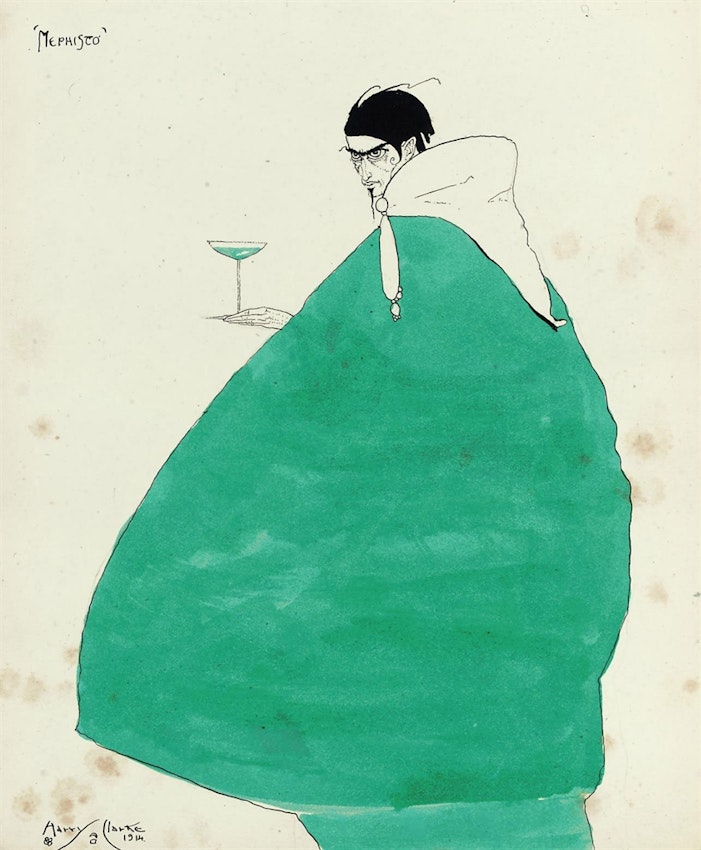 Scroll through the whole page to download all images before printing.
Scroll through the whole page to download all images before printing.Mephisto (1914), Clarke’s self-portrait as an absinthe drinking Mephistopheles — Source.
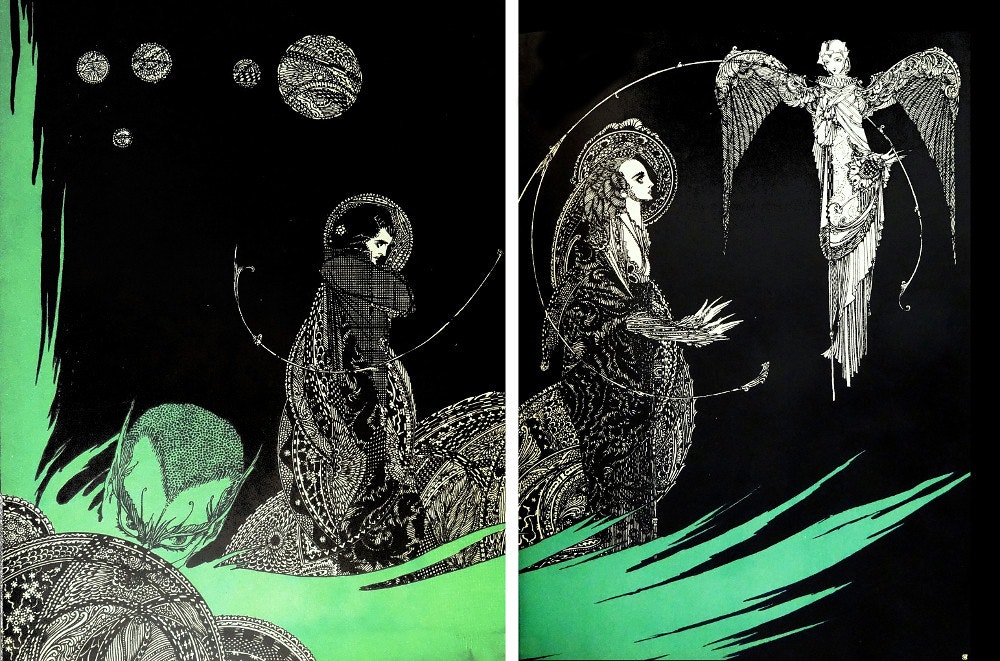 Scroll through the whole page to download all images before printing.
Scroll through the whole page to download all images before printing.The endpapers to Faust by Goethe (1925), Clarke as Faust appearing on the left hand page — Source (courtesy of Leo Boudreau)
Clarke’s earlier Mephisto hinted at his sense of personal connection to this story of temptation, evil, and damnation. Now, as if to further emphasize the association of himself with suffering, he depicts himself as Faust, the man who bargains with Mephistopheles. In his dummy mockup for Faust, Clarke’s portraits are all the more revealing of his own features; a sketch for the headpiece of the table of contents offers a tender, realistic portrayal of his own eyes seeking out the viewer.
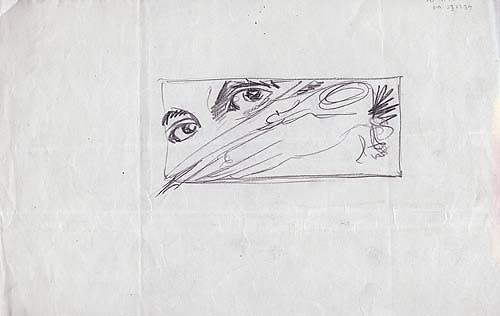 Scroll through the whole page to download all images before printing.
Scroll through the whole page to download all images before printing.Sketch for the table of contents decoration in Faust by Goethe — Source (not openly licensed).
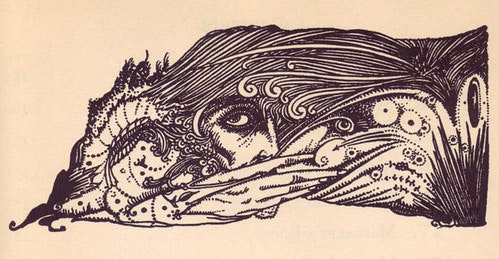 Scroll through the whole page to download all images before printing.
Scroll through the whole page to download all images before printing.The finished decoration, as it appears in Faust by Goethe (1925) — Source.
This self-portrait sketch becomes all the more notable in light of the pervasive images of eyes used to create a sense of surveillance in the Faust illustrations, as in the image of a bespectacled Clarke-as-Faust, or the scene in which he attempts to free Margaret from her dungeon. When Faust and Mephistopheles travel on horseback, it is the steeds who glance back at Clarke’s caricature-like portrait.
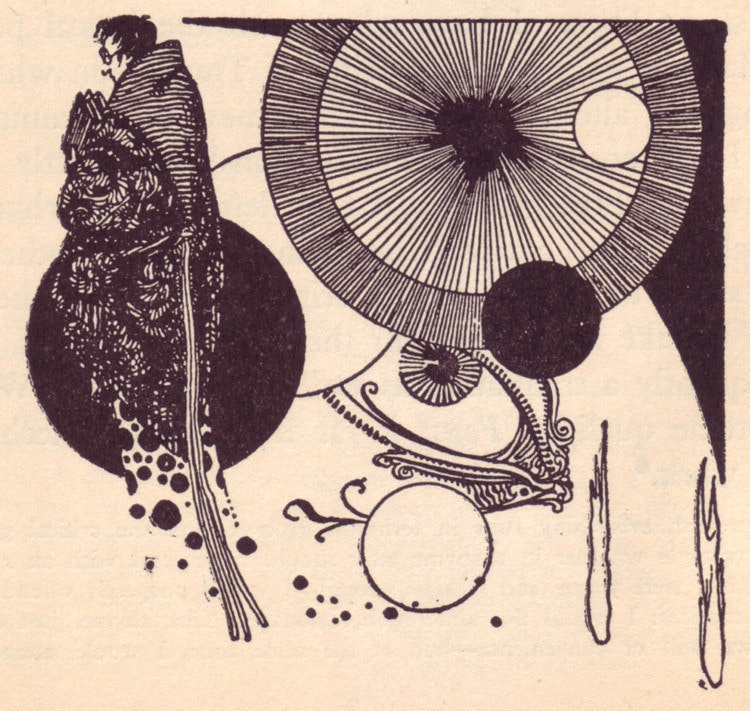 Scroll through the whole page to download all images before printing.
Scroll through the whole page to download all images before printing.Faust in glasses, Faust by Goethe (1925) — Source.
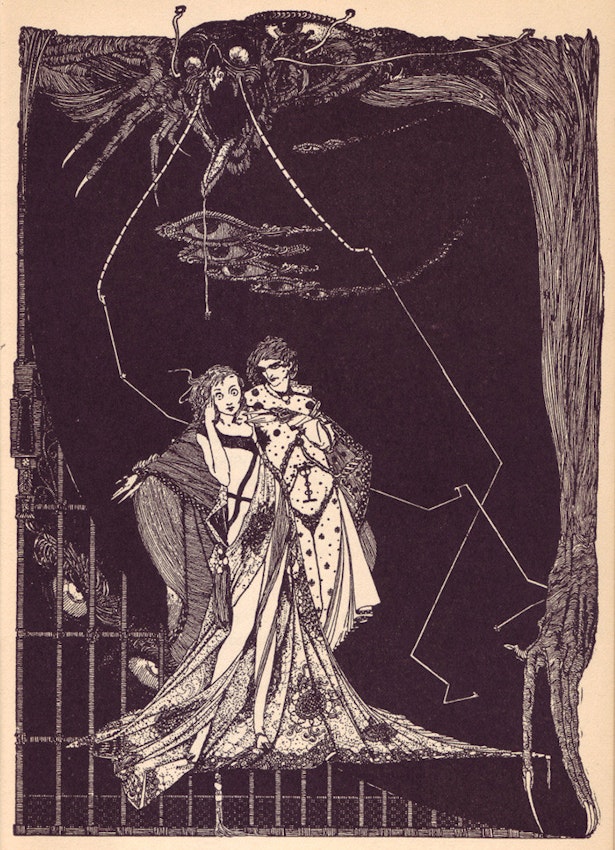 Scroll through the whole page to download all images before printing.
Scroll through the whole page to download all images before printing.Margaret in the dungeon, Faust by Goethe (1925) — Source.
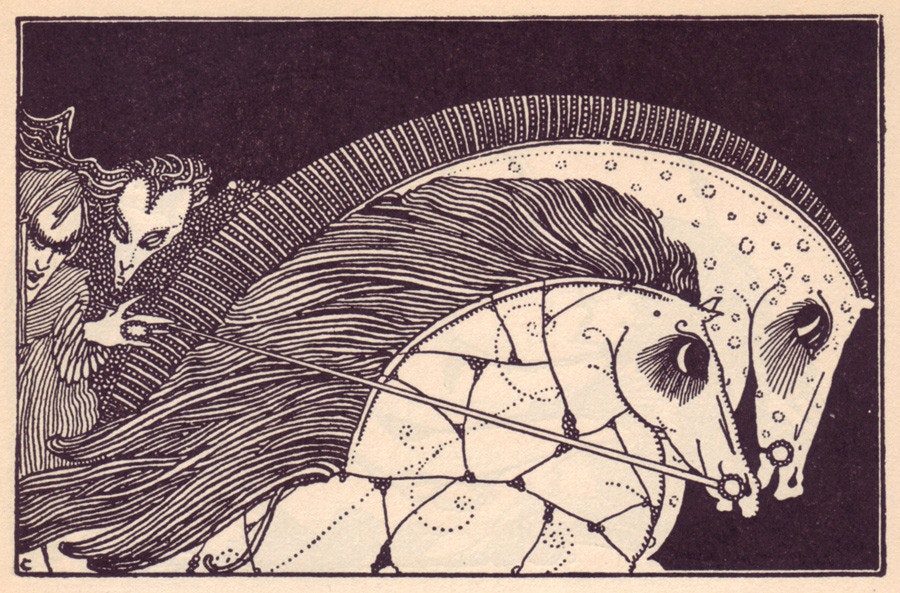 Scroll through the whole page to download all images before printing.
Scroll through the whole page to download all images before printing.Faust and Mephistopheles on their steeds, Faust by Goethe (1925) — Source.
Some of the most tortured illustrations in Faust are the tail pieces and small designs used to close chapters: in these, Clarke shows faces gnawed by rats, layers of bodies skewered on a sword, and he concludes with his own face in the unrelenting grip of Mephistopheles.1
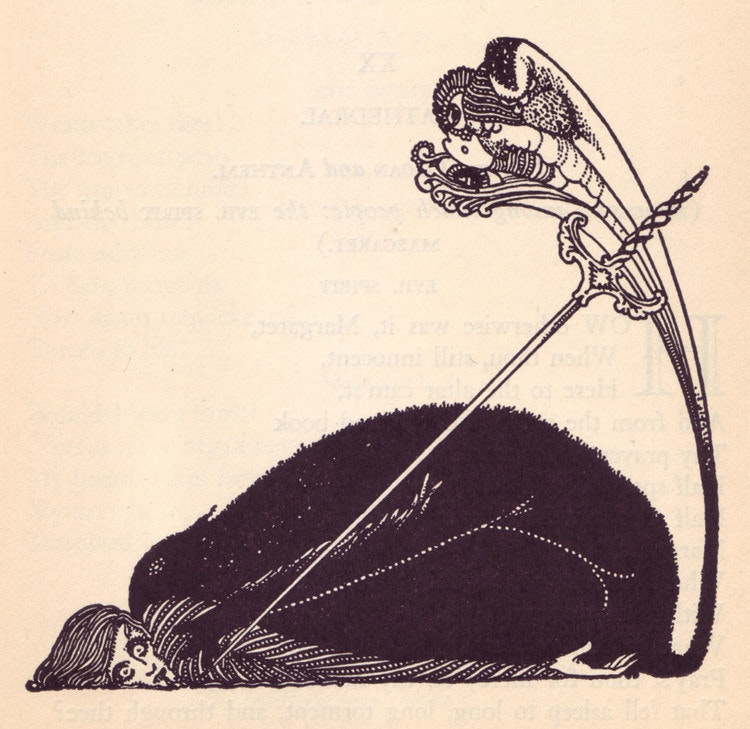 Scroll through the whole page to download all images before printing.
Scroll through the whole page to download all images before printing.Decoration in Faust by Goethe (1925) — Source.
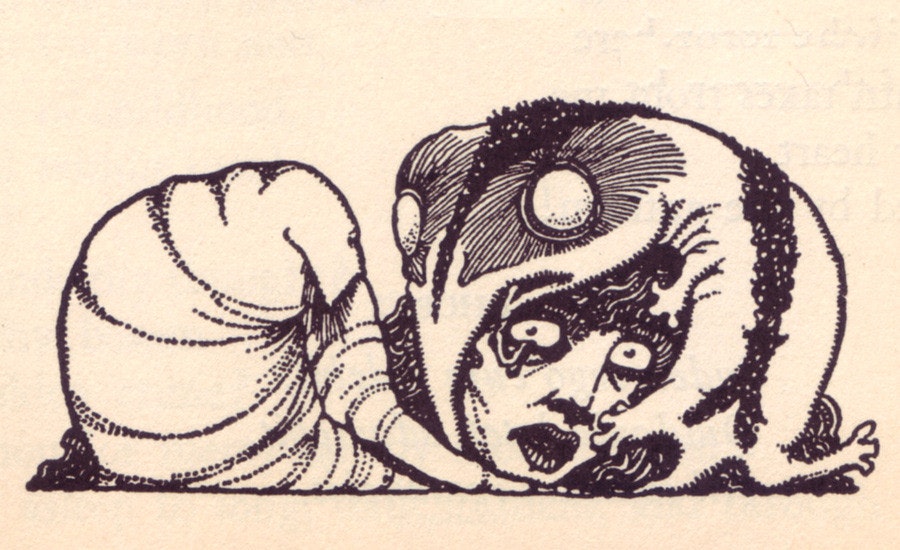 Scroll through the whole page to download all images before printing.
Scroll through the whole page to download all images before printing.Decoration in Faust by Goethe (1925) — Source.
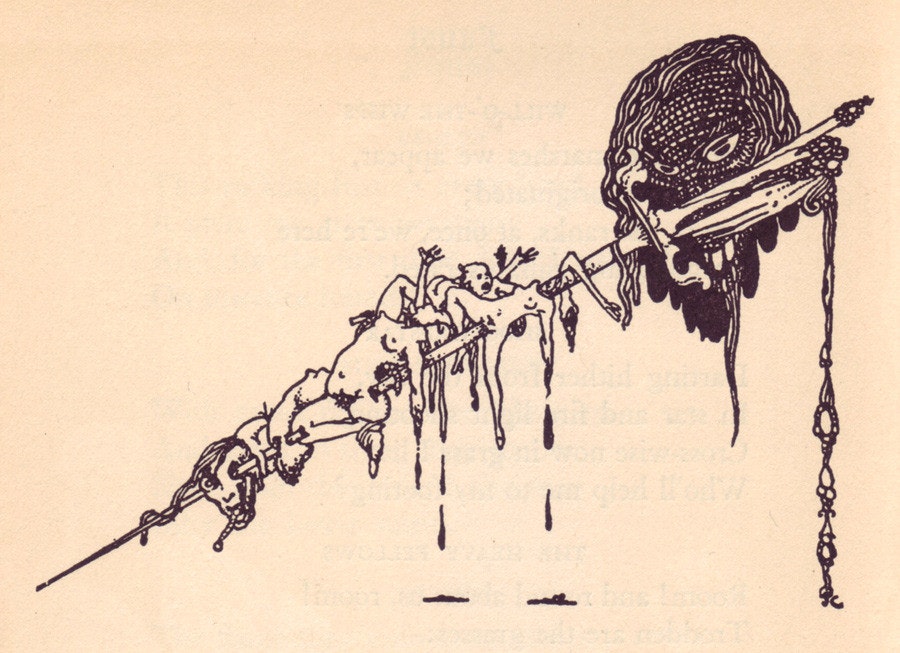 Scroll through the whole page to download all images before printing.
Scroll through the whole page to download all images before printing.Decoration in Faust by Goethe (1925) — Source.
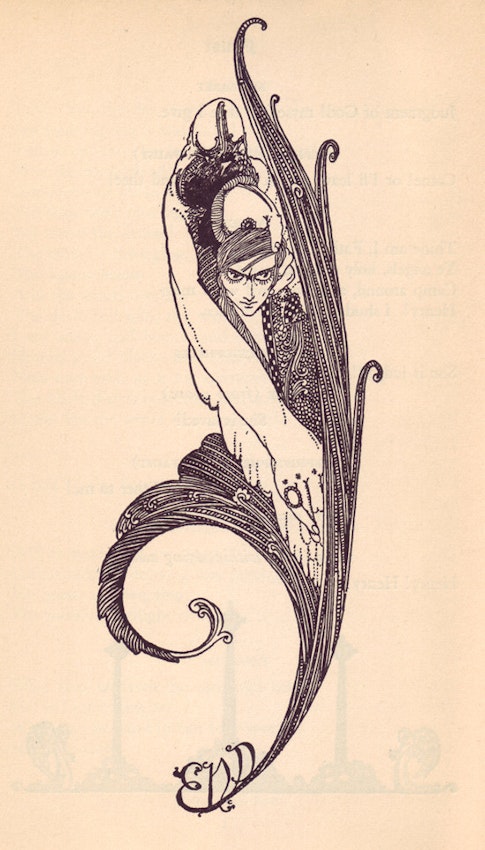 Scroll through the whole page to download all images before printing.
Scroll through the whole page to download all images before printing.Decoration in Faust by Goethe (1925) — Source.
Clarke believed Faust to be his best book, but reported in a letter to a friend that his publisher felt the illustrations were “full of stench and steaming horrors”. Clarke defended his work in another letter, saying it was “terribly, terribly sincere . . . ’tis horrid, I know — in fact, I had to laugh at my creations or I would have become morbid.” Surely the inclusion of self-portraits helped him — and help us — to get the joke.2
In a more surprising blend of the saintly with the sinful, Clarke didn’t limit self-portraits to book illustrations — his face also makes its way into his religious stained glass work. As one of the leading artists of the Irish Arts and Crafts movement, Clarke’s windows (and those his studio continued to produce in his style up until the 1970s) are instantly recognizable. His oftentimes strange vision became part of the established visual idiom of a newly independent Ireland in the 1920s and 1930s. Ireland had no indigenous stained glass work, but Clarke’s careful study of medieval aesthetics and techniques led critics to think of him as the inheritor of a broader European tradition. He traveled to see medieval glass in the great cathedrals of Chartres, Rouen, Amiens, and elsewhere. The playfulness and horror of the Gothic grotesque no doubt captured his imagination, and he brings a Gothic-influenced depiction of suffering, trauma, and death — often combined with a jesting playfulness — to his own glasswork.
His self-portraits figure in his stained glass from the very start. In his first major commission, the Honan Hostel Chapel windows, he portrays himself amongst a group of plague victims ostracized from St. Gobnait’s community in St. Gobnait (1916). His distorted face, with one eyeball destroyed by plague, is almost unrecognizable, but he hints at his likeness with his initials (and the window’s date) on the figure’s green cape.
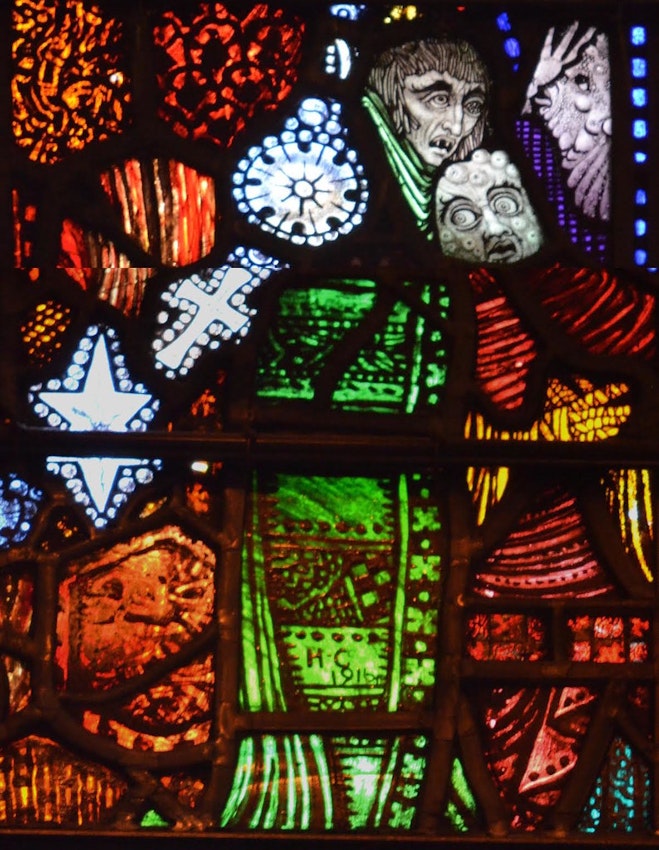 Scroll through the whole page to download all images before printing.
Scroll through the whole page to download all images before printing.Detail, St. Gobnait (1916) — Source: author’s photograph.
Clarke appears again in the small Our Lady of the Sorrows window completed in 1917, this time hidden near the top. In the companion window, Saint Joseph, he once more finds Seán Keating’s distinctive features irresistible, and gives them to St. Finbarr, featured in the lower panel depicting Joseph’s death. These two windows hang at eye level — unlike most of the stained glass he created for churches — perhaps in hope that certain visitors would recognize him and his friend.
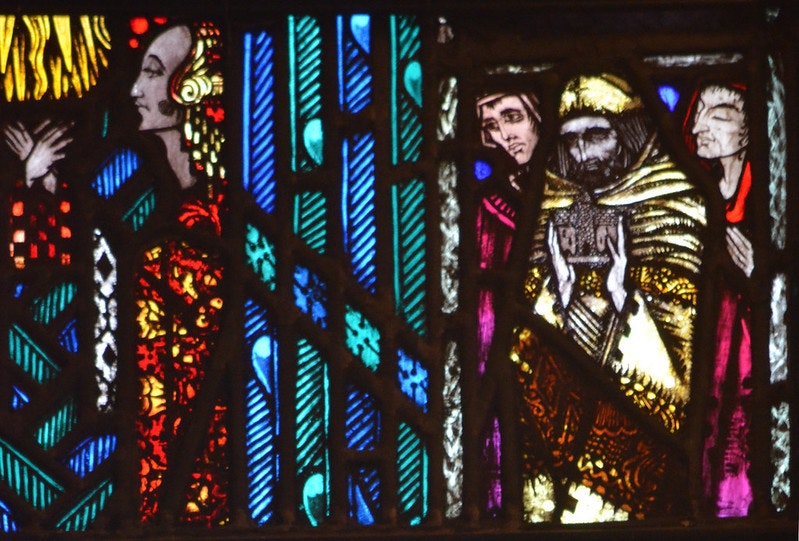 Scroll through the whole page to download all images before printing.
Scroll through the whole page to download all images before printing.Detail, Our Lady of the Sorrows (1917) — Source: author’s photograph.
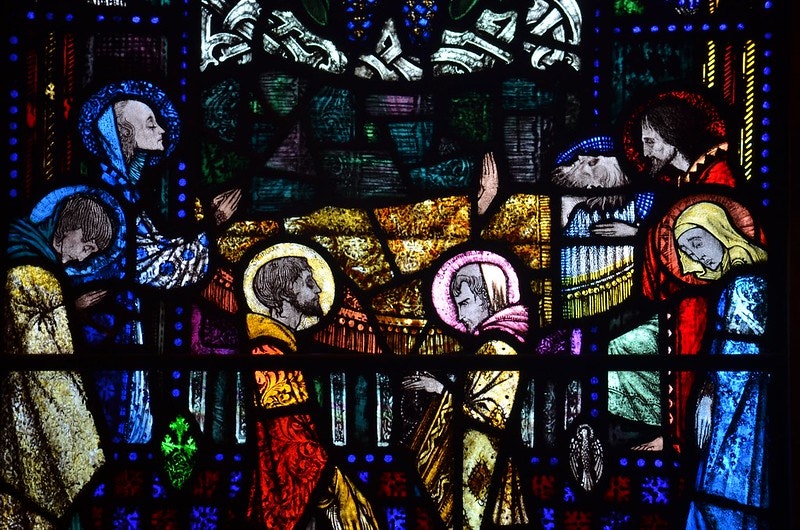 Scroll through the whole page to download all images before printing.
Scroll through the whole page to download all images before printing.Detail, Saint Joseph (1917) — Source: author’s photograph.
If Clarke’s interest in medieval stained glass techniques and the Gothic grotesque seems to mark his work as retrogressive, his self-portraits provide insight into a particularly modern means of composing. Clarke was fond of photography, and even records in his work diary a day spent “mucking [about] & taking photos”.3 On some occasions, he used photographs to set up models for difficult scenes in his windows, a practice he may have borrowed from Seán Keating who often did the same.4 For the 1920 Crucifixion in St. Michael’s Church in Terenure, Dublin, Clarke had trouble accurately depicting the angle of the crucified Christ’s body in the massive window positioned high in the wall; he asked his brother Walter to take his picture as he posed as Christ with his hands tied, and he designed the window from the prints. So Clarke’s Terenure Crucifixion, modeled off his own body, becomes a self-portrait — of a sort.
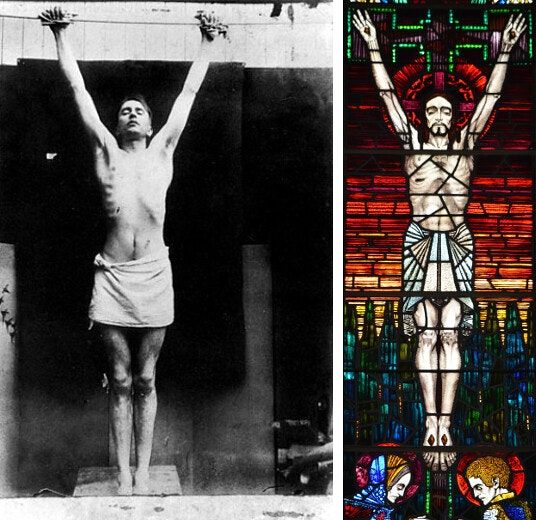 Scroll through the whole page to download all images before printing.
Scroll through the whole page to download all images before printing.Left: Photograph of Clarke in the posture of crucifixion — Source. Right: Detail, Crucifixion (1920) — Source: author’s photograph.
By the mid-1920s, Clarke was making some of his most accomplished stained glass, works peppered by his self-portraits hidden in and amongst the action. In his circa 1923 The Widow’s Son, one of two remarkable lights made for the Catholic Church in Balbriggan, County Dublin, one of the disciples almost hidden behind Jesus’ left shoulder, and wearing a spotted purple scarf, seems to have Clarke’s long nose and full, pouting mouth.
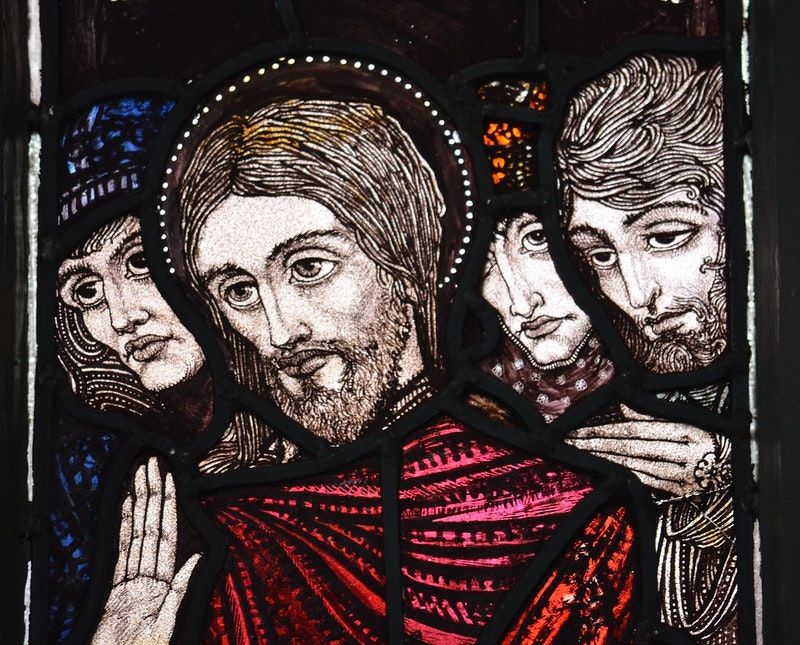 Scroll through the whole page to download all images before printing.
Scroll through the whole page to download all images before printing.Detail, The Widow’s Son (1923) — Source: author’s photograph.
In the 1924 Dempsey Memorial Lancet Window of St Maculind, made for St. MacCullin’s Church, Lusk, just eleven kilometers down the road, Clarke portrays himself among the sick parishioners gathered around the Irish St. Maculind for healing. Also present in this circle of faces meticulously arranged in a vesica piscis is the memento mori of a half-decomposed figure nearly all skull.
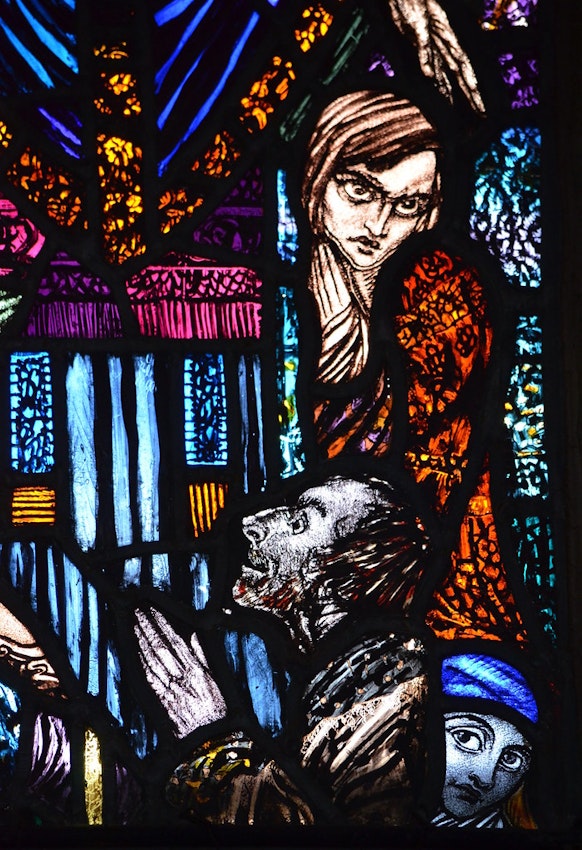 Scroll through the whole page to download all images before printing.
Scroll through the whole page to download all images before printing.Detail, Dempsey Memorial Lancet Window of St Maculind (1924) — Source: author’s photograph.
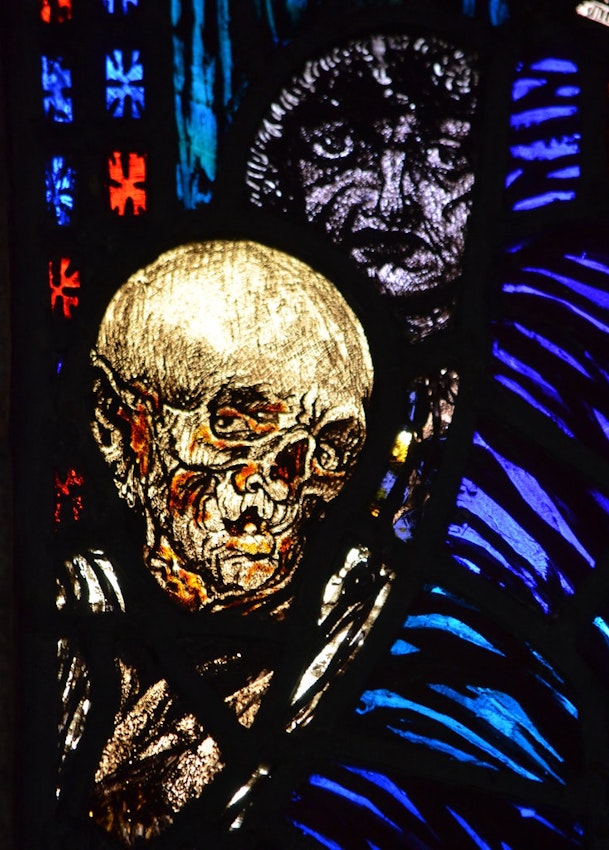 Scroll through the whole page to download all images before printing.
Scroll through the whole page to download all images before printing.Detail, Dempsey Memorial Lancet Window of St Maculind (1924) — Source: author’s photograph.
Harry Clarke has been praised as one of the greatest inheritors of the medieval glass tradition. Something of the grotesque humor in the suffering figures of Gothic glass must have appealed to Clarke’s sensibilities, particularly in the later years of his life when he knew he was dying from tuberculosis. By 1930, when work was picking up for the studios with the first commissions from the United States completed, Clarke had to spend more and more time in a sanitarium in Davos, Switzerland. Back in Ireland, an important commission came from a church in Newport, County Mayo, and Clarke designed and oversaw as much of the Last Judgment as he was able to do. Nevertheless, he died before the window was fully complete, and it was up to the skilled workmen in his studios to finish it from his drawings and color schemes. Thus Clarke’s last self-portrait is a kind of posthumous one: in the Last Judgment’s lower right corner, we see Clarke himself — portrayed upside down in a sickly green — descending to hell amongst the tortured souls and grotesque creatures he so often envisioned.
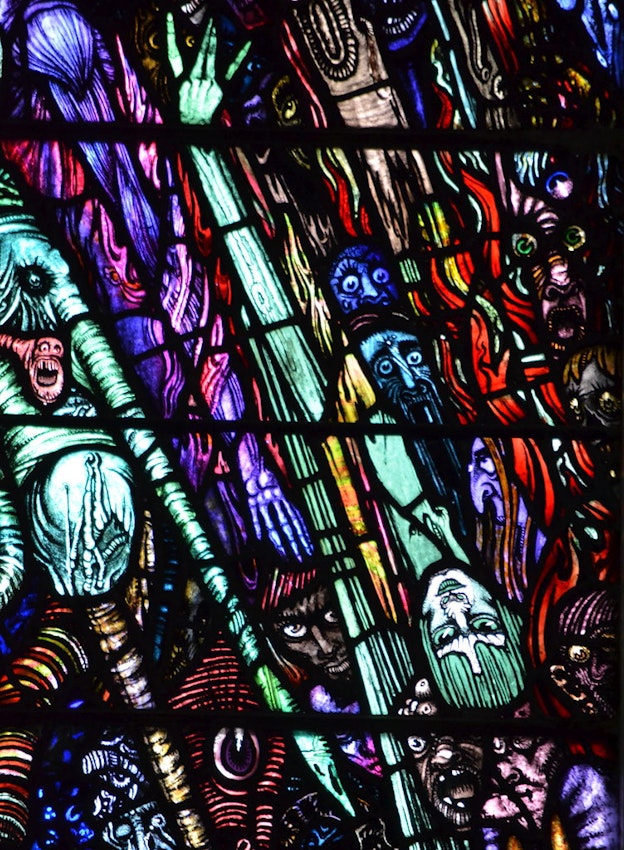 Scroll through the whole page to download all images before printing.
Scroll through the whole page to download all images before printing.Detail, Last Judgment (1931) — Source: author’s photograph.
The legacy of poor health that plagued Clarke throughout his life must have had a profound effect on his work, evidenced not least of all through his inclination toward self-portraiture. Although he left few private letters and offered little insight into his personal life, a note in his 1914 work diary indicates that thoughts of illness might have been a source of anguish — and perhaps of inspiration — even then. Scribbled and then circled amidst a list of business acquaintance addresses, Clarke writes out the final lines of J. M. Synge’s last (unpublished) poem, asking, “What will they write / of my poor passage to the stall of night?” It is, however, in fact a misquote, with the original reading “What year will they write”.5 Was Clarke perhaps deliberately misquoting Synge, whom he admired, and who, like him, died early after fighting illness and writing for many years under the conviction of his coming death? Synge’s poem indicates his anxiety about the final date of his impending death in 1909, but Clarke’s misquotation seems to hint at a concern, instead, about an artist’s reputation.
Although Harry Clarke found renown as a stained glass artist in Ireland, and his illustrations reached an international audience in the 1920s and after, he remains obscure, a legacy he may have anticipated and tried to counteract through active allusion to the long tradition of self-portraiture in art. As one of the leading figures of the Irish Arts and Crafts movement, Clarke’s images helped shape the Irish Free State’s visual idiom in the 1920s and beyond, but his long-term reputation as an artist seems to have been hindered by the fact he worked primarily in the medium of stained glass. If his troubled, and often troubling, windows, illustrations, and self-portraits provided a coherent outlook for an Ireland in the coming times, it appears to have been a dark vision, one in keeping with the apocalyptic futures so many modernists foresaw in the 1930s, the decade he only just glimpsed. Like many other artists working in this time, his work reflects the shaping forces of early-twentieth-century modernism: of military, technological, scientific, and intellectual shifts that turned artists and writers toward an examination of interiority and psychology.
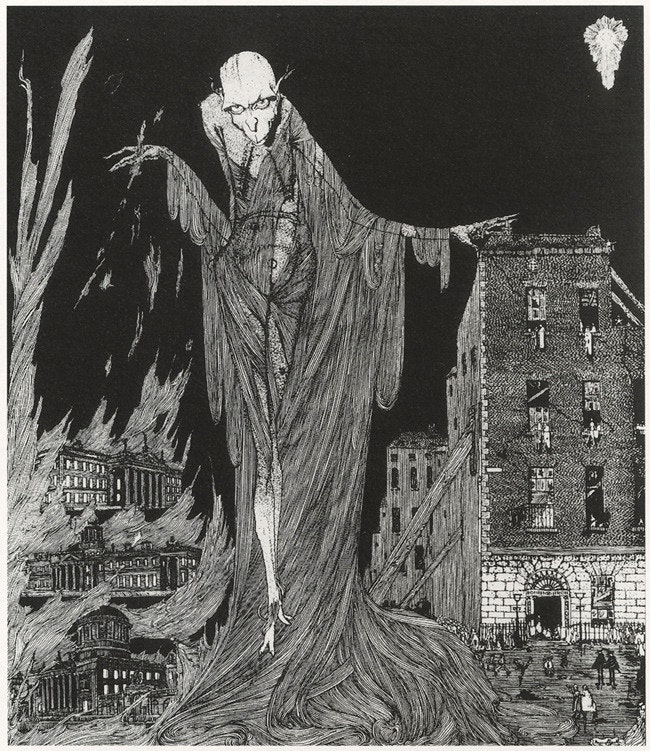 Scroll through the whole page to download all images before printing.
Scroll through the whole page to download all images before printing.Clarke’s The Last Hour of the Night (1922), the frontispiece for Dublin of the Future, the prize-winning design for an urban planning competition staged in 1914 (but not published until 1922 because of the intervening violence and devastation) — Source.
Clarke didn’t have to leave Dublin to experience the extremes of early-twentieth-century modern life: in 1916 in Dublin, the Easter Rising brought urban warfare directly to the city’s streets, and the subsequent War of Independence and Irish Civil War kept the British colony and later Irish Free State in a constant state of violent conflict.6 Perhaps more profoundly, Clarke witnessed first-hand extreme poverty, urban decay, and disease; the aristocratic Georgian mansions that lined the streets of north inner-city Dublin near to where Clarke had his studios represented the worst housing conditions of any city in the United Kingdom.7 His 1922 illustration, The Last Hour of the Night, directly responds to these conditions in the capital city, with a Nosferatu-inspired figure prowling through the shambles of Georgian tenements, and the monuments of colonial Dublin still burning after the battles of the War of Independence and Civil War, a personification of the Gothic afterlife of postcolonial rule.8
Clarke’s scene vividly portrays the connection between his medieval-inspired imagination and interest in the grotesque, and the political and social events of the early twentieth century that shaped his work. His self-portraits offer another response to these same shaping forces, indicating to us just how much his personal vision, and his experience of modern Dublin, influenced the stained glass and illustrations he made. Yet for all the modernist unease in evidence in his work, his self-portraits also provide moments of humor and even self-preservation. We can see his portraits as the artistic measure of the times — dark, foreboding, “full of steaming horrors” — but also as invitations to laugh with him at his creations, so none of us grows too morbid.
Kelly Sullivan is Assistant Professor/Faculty Fellow of Irish Studies at New York University. She writes about British and Irish literature of the 1930s and 1940s, and also publishes poetry and fiction. You can find more information on her website: KellyESullivan.com





